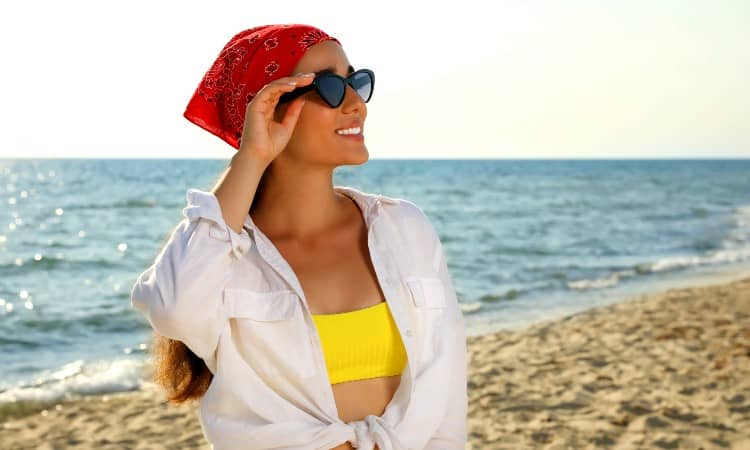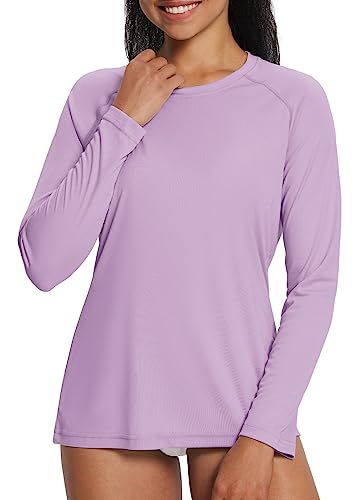I like to spend time outside when the weather’s nice. Although, I’m getting concerned about UV rays and the damage they can cause to the skin. You see, sun protection cream is not enough. UV light can go through clothing. So how can I stay outdoors and be safe in the sun? What is the best fabric for sun protection?
The best fabric for sun protection is one with a UPF rating of 50 or above. UPF stands for Ultraviolet Protection Factor. Synthetic fibers like polyester and nylon offer greater protection than natural fibers. The weave and color of the fabric are also important. A tightly woven, dark-colored denim weave is better than loosely woven white linen.
Continue reading this article to find out more about UVA and UVB rays. You’ll discover how to protect your skin from sun damage and which fabric has the best UPF rating. What is the best fabric for sun protection? Let’s find out!

Do Your Clothes Protect You From UV?
Unfortunately, not all clothes will protect your skin from exposure to harmful UV rays. Some offer very little protection and can lead to serious sunburn.
It’s important to consider the type of fabric and the thickness of the material when looking for clothing. The more lightweight or loosely woven the garment is, the less protection it will give.
This can be a bit problematic. We tend to wear lightweight and loose-fitting garments in the summer when the sun is at its hottest. Summer is also when we spend more time outside, usually in t-shirts, shorts, or floaty summer dresses. All of which are made from summer-weight fabrics, so they can be light, airy, and cooling.
Even on a cloudy day, 80% of the sun’s UVA and UVB rays can reach your skin. Ideally, your garments should have more substance to them. A heavier weight fabric in a tight weave can reduce the amount of dangerous UV light reaching your skin to practically zero. An indigo blue or black colored pair of denim jeans are perfect.
There’s one slight issue, though. Wearing densely woven denim when the temperature is pushing 90ºF isn’t practical. Or particularly comfortable. So what can you do to protect yourself from harmful rays?
One way is to buy clothing with a UPF rating. This works a lot like an SPF rating on sun cream. The Sun Protection Factor of a cream lets you know how long you can stay out in the sun before your skin is at risk of burning. Higher ratings indicate more protection for bare skin.
A UPF50+ rating on garments means they have the highest protection against sun damage. These are the clothes you should be looking for when buying your summer wardrobe.
What Does UPF Mean?
UPF stands for Ultraviolet Protection Factor. Only garments and fabric with a UPF rating are considered capable of protecting your skin from damage.
Just like with suncream, there are different levels of protection available. UPF50 means only 1/50th or 2% of UV rays can get through to your skin. A rating of UPF50+ indicates the protection is even higher.
You need to be careful when shopping for UPF rated sun protective fabric. Some retail outlets advertise sun protection material as SPF and give it an SPF rating. This is inaccurate and misleading.
SPF refers to the Sun Protective Factor of sun cream and lotions. It measures the amount of time skin exposed to UV takes to go red.
Let’s assume you know your skin starts to burn after being in the sun for 5 minutes. Sun cream with a rating of SPF15 allows you to stay in the sun for up to 15 times longer. So you get to sunbathe for an hour and 15 minutes.
Fabric isn’t rated by the amount of time spent in the sun. A UPF rating is based on the amount of UV radiation that can get through the material and reach your skin. That’s a key difference. To be protective, a garment must be made from a fabric able to block the radiation emitted by UV light.
This is why fabric ratings are different from sun cream. Always ensure the fabric or garment you want to buy has a UPF50 or higher rating.
Why UPF50+ Clothing Is Important for Your Health?

The main cause of skin cancer is exposure to harmful UV light. Ultraviolet rays can be found in natural sunlight, tanning beds, and sunlamps. Radiation attacks the skin, causing blemishes that can change in shape or color. In severe cases, skin cancer can show as non-healing sores or wounds which heal, then return.
Ultraviolet rays come in two forms. UVA rays are the ones that cause skin aging. These rays attack your skin throughout daylight hours. They are also the ones that penetrate deeper into the epidermis and cause more permanent damage.
UVB rays burn your skin. They attack the surface and top layers of flesh. Damage may be temporary, like a bad sunburn or a slightly red area of skin. You’ll be exposed to these rays at the hottest part of the day, which can be anywhere between 10 am – 4 pm, or even later, depending on where you are.
When wearing a t-shirt, you can apply suncream to the part not covered by the garment. As long as you follow the directions on the bottle, you can stay in the sun for an allotted time. The amount of time will depend on the SPF of the cream. Although, you should cover up if you start to feel your skin getting warm.
Suncream isn’t infallible, though. It can rub off or even wash off in the pool. Worse, you could simply forget to apply any. Most of the time, you only apply it to skin exposed to sunlight. Applying suncream underclothing is possible but can be sticky and may end up on your clothes rather than your skin.
UPF50+ fabric doesn’t have a time limit and doesn’t rub off. The clothing will block damaging UV rays for as long as you are out in the sun. This is one of the main reasons sun protection clothing is an essential part of your everyday life. It doesn’t need re-applying and isn’t time-specific.
Better still, you don’t have to remember to put it on. None of us leave the house without our clothes. Getting dressed is second nature.
There are different levels of severity in skin cancer, from basal cell cancer to more serious melanoma. It’s a nasty thing to have on any level. This is why it’s important to take steps to block the radiation from the sun from reaching your skin. UPF50+ rated fabric in your clothing is the best way to do that.
How to Make a Fabric UPF50+
Fabric can have added protection from UV light included during the production process. Manufacturers will add UV-absorbing chemicals to their clothing textiles before they are spun or woven into garments. This is known as pre-treating the fabric.
The resulting pre-treated garments will have UPF ratings and approval markings on their labels and sale tags. You’ll be able to tell they are UPF compliant while they are still on the clothing rack in the store.
Another method used in the production of UPF50+ fabrics is to dye the material with a colorless dye. It’s a special coating applied to the material once the colored dye has been added.
It’s similar to a protective layer of varnish. One of the main issues with the colorless dye option, although it blocks UV radiation, the coating isn’t permanent. A couple of cycles in the washing machine is all it takes to strip the coating off.
Fabrics With Low UPF Protection
Fabrics with a low rating for ultraviolet protection are lightweight, loosely woven, and light-colored. A white, summerweight linen dress is going to be great at keeping you cool and fresh. But it won’t be great at keeping out UV rays. They’ll be able to get through to your skin in no time.
Other fibers known to have low UPF ratings are lightweight cotton, viscose, flax, and hemp. Most of those have a rating of UPF25 or lower. Some only manage a rating of UPF 5. Anything lower than UPF30 isn’t considered protective at all.
The reason for the low ratings is down to the weave and color of the textile used in the garment. A loose weave or knitted fabric will have holes. These holes allow UV rays to filter through. Light-colored fabric can’t absorb as much UV light as a darker material will. Instead, a light-colored shirt will allow more of the dangerous rays to soak through and reach your flesh.
Talking about soaking, be careful in the summer rain. It may feel refreshing to stand out in a summer downpour but, you may be over-exposing your skin to UV radiation. Fabric loses as much as 50% of its UPF protection when it gets wet.
Best Fabric for Sun Protection
Many people believe natural fabrics offer the best protection from sun damage. This is based on the fact natural fibers have been around for centuries. While that’s true, sun protection properties are not necessarily down to the specific fabric or fiber.
UV protection may be higher with synthetic fabrics like polyester and nylon. Not because they are manmade, but more because of how they are formed into a fabric.
A textile’s weave and density is the main factor to consider when looking at sun protection. So too is the color of the material. With that in mind, let’s take a look at some different fabrics to see how well they perform as sun protection.
Denim
 A tried and tested fabric synonymous with cowboys of the wild west, ranch hands, and manual labor, denim clothing is the epitome of life outside.
A tried and tested fabric synonymous with cowboys of the wild west, ranch hands, and manual labor, denim clothing is the epitome of life outside.
It’s a hardwearing fabric designed for hard work. Tough, durable, but more importantly densely woven, denim has a UPF rating of 1700.
Before you go and cover yourself from head to toe in denim garments, there’s a huge downside with this fabric. If you’ve ever worn denim jeans to an outside party when the temperature is 80ºF in the shade, you’ll know its comfort factor goes out of the window when it’s hot.
Polyester
 Lighter than denim and a popular fabric for summer weight clothing, polyester’s rating is also UPF 1700. Polyester’s UV resistance is one of the highest out of all the natural or manmade fibers available today.
Lighter than denim and a popular fabric for summer weight clothing, polyester’s rating is also UPF 1700. Polyester’s UV resistance is one of the highest out of all the natural or manmade fibers available today.
As it’s plastic, polyester is used for more than clothing. Outdoor equipment and ropes made from polyester are known to have longevity even in constant sunlight. Depending on the type of polyester, fibers can be exposed to sunlight for 12 months and still have at least 67% of their UV protection capabilities.
As with denim, polyester clothing can be problematic in hot weather. It doesn’t breathe and can make you feel sweaty, hot, and uncomfortable.
Nylon
 Although nylon does have UV resistance, it’s not as high as polyester. Nor is it as long-lasting. Regular exposure to UV rays will cause nylon to fade and de-stabilize. Outdoor equipment made from nylon can start to show signs of decay relatively quickly. It becomes brittle and leaves trails of dust.
Although nylon does have UV resistance, it’s not as high as polyester. Nor is it as long-lasting. Regular exposure to UV rays will cause nylon to fade and de-stabilize. Outdoor equipment made from nylon can start to show signs of decay relatively quickly. It becomes brittle and leaves trails of dust.
Nylon fabric will offer some protection from UV radiation and has a high UPF rating when new. Don’t expect your nylon garment to last season after the season, though. As soon as you see signs of fading, it’s time to replace it.
Wool
 Wool is an excellent barrier against ultraviolet rays. Even untreated wool can absorb radiation at a far greater level than many of its natural fiber siblings. Water tends to disrupt its capacity to protect you, though.
Wool is an excellent barrier against ultraviolet rays. Even untreated wool can absorb radiation at a far greater level than many of its natural fiber siblings. Water tends to disrupt its capacity to protect you, though.
Because it gets wet and stays wet, its UPF rating is lower than you’d expect. You’re looking at around a UPF20 – 50, depending on the type of wool. Merino wool is at the higher end of that scale. As wool has inbuilt UPF protection, many manufacturers will add chemicals to improve the barrier but be aware; any additives are likely to be short-lived.
Silk
 Silk can be considered a fabric with UV protection properties up to a point. The protection offered is low to moderate, and it depends on the weave of the silk.
Silk can be considered a fabric with UV protection properties up to a point. The protection offered is low to moderate, and it depends on the weave of the silk.
A shiny satin weave in your silk will offer a greater level of UV blockage. This type of silk fabric is better able to reflect the sun’s rays away from your body. In doing so, it bounces the radiation away from your skin. A darker-colored silk satin will work better than a light color.
Pre-Treated fabrics
 Fabrics pre-treated with chemicals to enhance UV protection are considered to be among the best options.
Fabrics pre-treated with chemicals to enhance UV protection are considered to be among the best options.
The treatments are permanent and become part of the material. Ratings for this kind of fabric are all in the UPF50+ range.
Most of these fabrics are specifically made for clothing manufacturers. Brand names to watch out for include Solumbra, Textililene, and Luminora.
Dark-Colored Fabrics
It’s a well-known fact that darker fabrics reflect light. This is instrumental in making darker clothing incredibly good at blocking UV radiation. As the radiation is carried by sunlight, it gets reflected away from you along with the light.
Colors to watch for include black, indigo blue, and dark green. Combined with a tight weave, dark colors can help form an impenetrable barrier against UVA and UVB rays.
Best Swimwear Fabric for Sun Protection
A nylon and spandex mix is the best fabric for use in swimwear. The UPF rating for this type of material is UPF50+. Spandex not only gives the swimsuit a comfortable stretch but also enhances the UPF of nylon. In turn, nylon will improve the chlorine resistance for spandex. It’s a winning combination.
However, neither nylon nor spandex can survive continual exposure to either UV light or chlorine. A nylon/spandex blend will degrade over time. Partly because of the radiation in the UV rays and partly due to the frequent washes to remove the chlorine.
It’s important to change your swimsuit at the first sign of decay. This can include fading or signs of pilling. Any damage will reduce the amount of UV protection. When it comes to swimsuits, it’s OK to keep up with the latest fashion as it’s recommended to change your suit every season.
Don’t rely on your swimwear for total protection from the sun’s UV rays. Always cover your bare skin with suitable, waterproof sun cream protection.
Ways to Improve UPF Protection
Before you empty your wardrobe of all the non-UPF clothing you own, Let’s take a step back. There are ways to improve the protection of the garments you already wear. Even how you wear them can make a difference.
Your linen shirt or dress can still be worn safely in the sun. Better still, it can offer you UV protection. All you need to do is remember to add a product like SunGuard to your laundry. The protection may be temporary and will need re-applying, but at least you get to wear your favorite t-shirt on a hot day.
Consider how to combine your clothing for a full barrier of protection. A wide-brim hat will shade your face from the strength of the sun’s glare and cut down on the amount of radiation reaching your neck and shoulders. Worn with a lightweight, long-sleeved blouse or shirt, your upper body will have full protection.
Wearing long trousers or pants will do the same for your legs, particularly if you make sure the material is lightweight but tightly woven. The fewer holes in the fabric, the better the UPF rating.
Another thing to keep in mind is the fit of your clothing. On days UV levels are high, wear loose-fitting garments. A tight-fitting t-shirt may look great, but stretching the fabric across your torso will reduce the UV protection because it’s stretching the fibers. Stick to a baggy shirt for those hotter days. You may even find you’ll feel cooler too!
Conclusion
Fabric offering a sun protection rating of UPF50+ is best for blocking harmful UV rays. Used with a suncream of SPF15 or higher on exposed skin, you’ll have total body protection.
Let me know in the comments if you liked this article. Have you bought any UPF50+ clothing? Or added UV protective additives to your wash? How did you get on?